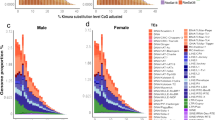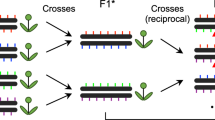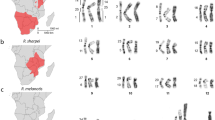Abstract
Genetic models1,2 predict that genomic rearrangement in hybrids can facilitate reproductive isolation and the formation of new species by preventing gene flow between the parent species and hybrid (sunflowers are an example3). The mechanism underlying hybridization-induced chromosome remodelling is as yet unknown, although mobile element activity has been shown to be involved in DNA rearrangement in some dysgenic Drosophila hybrids4,5. It has been proposed that DNA methylation evolved as a means of repressing the movement of mobile elements (the host defence model6,7). If such a protective mechanism were to fail, mobile elements could be activated, and could cause major and rapid genome alterations8,9. Here we demonstrate the occurrence of genome-wide undermethylation, retroviral element amplification and chromosome remodelling in an interspecific mammalian hybrid (Macropus eugenii × Wallabia bicolor). Atypically extended centromeres of Macropus eugenii derived autosomes in the hybrid were composed primarily of an unmethylated, amplified retroviral element not detectable in either parent species. These results, taken with the observation of deficient methylation and de novo chromosome change in other mammalian hybrids, indicate that the failure of DNA methylation and subsequent mobile-element activity in hybrids could facilitate rapid karyotypic evolution.
This is a preview of subscription content, access via your institution
Access options
Subscribe to this journal
Receive 51 print issues and online access
$199.00 per year
only $3.90 per issue
Buy this article
- Purchase on Springer Link
- Instant access to full article PDF
Prices may be subject to local taxes which are calculated during checkout






Similar content being viewed by others
References
Grant, V. The regulation of recombination in plants. Cold Spring Harb. Symp. Quant. Biol. 23, 337–363 (1958).
Templeton, A. R. Mechanisms of speciation—a population genetic approach. Annu. Rev. Ecol. Syst. 12, 23–48 (1981).
Rieseberg, L. H., Van Fossen, C. & Desrochers, A. M. Hybrid speciation accompanied by genomic reorganization in wild sunflowers. Nature 375, 313–316 (1995).
Engels, W. R. & Preston, C. R. Formation of chromosome rearrangements by P factors in D. melanogaster. Genetics 107, 657–678 (1984).
Petrov, D. A., Schutzman, J. L., Hartl, D. L. & Lozovskaya, E. R. Diverse transposable elements are mobilized in hybrid dysgenesis in Drosophila virilis. Proc. Natl Acad. Sci. USA 92, 8050–8054 (1995).
Bestor, T. H. & Tycko, B. Creation of genomic methylation patterns. Nature Genet. 12, 363–367 (1996).
Yoder, J. A., Walsh, C. P. & Bestor, T. H. Cytosine methylation and the ecology of intragenomic parasites. Trends Genet. 13, 335–340 (1997).
Arnault, C. & Dufournel, I. Genome and stresses: reactions against aggressions, behavior of transposable elements. Genetica 93, 149–160 (1994).
Wichman, H. A., Van Den Bussche, R. A., Hamilton, M. J. & Baker, R. J. Transposable elements and the evolution of genome organization in mammals. Genetica 86, 287–293 (1992).
Smith, M. J., Hayman, D. L. & Hope, R. M. Observations on the chromosomes and reproductive systems of four Macropodine interspecific hybrids (Marsupialia: Macropodidae). Aust. J. Zool. 27, 959–972 (1979).
Toder, R. et al. Comparative chromosome painting between two marsupials: origins of an XX/XY1Y2 sex chromosome system. Mamm. Genome 8, 418–422 (1997).
Holland, J. et al. Rapid evolution of RNA genomes. Science 215, 1577–1585 (1982).
Graur, D. Pattern of nucleotide substitution and the extent of purifying selection in retroviruses. J. Mol. Evol. 21, 221–231 (1985).
Jaenisch, R., Schnieke, A. & Herbers, K. Treatment of mice with 5-azacytidine efficiently activates silent retroviral genomes in different tissues. Proc. Natl Acad. Sci. USA 82, 1451–1455 (1985).
Sunkel, C. E. & Coelho, P. A. The elusive centromere: sequence divergence and functional conservation. Curr. Opin. Genet. Dev. 5, 756–767 (1995).
Curcio, M. J. & Morse, R. H. Tying together integration and chromatin. Trends Genet. 12, 436–438 (1996).
Loebel, D. A. & Johnston, P. G. Analysis of DNase I activity and methylation of active and inactive X chromosomes of kangaroos (Macropus robustus) by in situ nick translation. Chromosoma 102, 81–87 (1993).
Li, E., Bestor4, T. H. & Jaenisch, R. Targeted mutation of the DNA methyltransferase gene results in embryonic lethality. Cell 69, 915–926 (1992).
Jacobsen, S. E. & Meyerowitz, E. M. Hypermethylated SUPERMAN epigenetic alleles in Arabidopsis. Science 277, 1100–1103 (1997).
Weiss, A., Keshet, I., Razin, A. & Cedar, H. DNA demethylation in vitro: involvement of RNA. Cell 86, 709–718 (1996).
Sambrook, J., Fritsch, E. F. & Maniatis, T. Molecular Cloning: A Laboratory Manual(Cold Spring Harbor Laboratory Press, Cold Spring Harbor, New York, (1989).
Schemp, P. W. & Meer, B. Cytologic evidence for three human X-chromosomal segments escaping inactivation. Hum. Genet. 63, 171–174 (1983).
Toder, R., Wilcox, S. A., Smithwick, M. & Graves, J. A. M. The human/mouse imprinted genes IGF2, H19, SNRPN, and ZNF127 map to two conserved autosomal clusters in a marsupial. Chromosome Res. 4, 295–300 (1996).
Lichter, P., Cremer, T., Borden, J., Manuelidis, L. & Ward, D. C. Delineation of individual human chromosomes in metaphase and interphase cells by in situ suppression hybridization using recombinant DNA libraries. Hum. Genet. 80, 224–234 (1988).
Acknowledgements
We thank M. Eldridge for swamp wallaby, tammar wallaby, Petrogale sp. and hybrid material, M. Renfree for tammar wallaby material, and I. Barbieri for cell preparations from BE-1.
Author information
Authors and Affiliations
Corresponding author
Supplementary information
Supplementary Information
Supplementary Information (PDF 491 kb)
Rights and permissions
About this article
Cite this article
O'Neill, R., O'Neill, M. & Graves, J. Undermethylation associated with retroelement activation and chromosome remodelling in an interspecific mammalian hybrid. Nature 393, 68–72 (1998). https://doi.org/10.1038/29985
Received:
Accepted:
Issue Date:
DOI: https://doi.org/10.1038/29985
This article is cited by
-
Identification, evolution and expression analyses of the whole genome-wide PEBP gene family in Brassica napus L.
BMC Genomic Data (2023)
-
Studying phenotypic variation and DNA methylation across development, ecology and evolution in the clonal marbled crayfish: a paradigm for investigating epigenotype-phenotype relationships in macro-invertebrates
The Science of Nature (2022)
-
The challenges of predicting transposable element activity in hybrids
Current Genetics (2021)
-
Epigenetic variation in animal populations: Sources, extent, phenotypic implications, and ecological and evolutionary relevance
Journal of Biosciences (2021)
-
Hybrid dysgenesis in Drosophila virilis results in clusters of mitotic recombination and loss-of-heterozygosity but leaves meiotic recombination unaltered
Mobile DNA (2020)
Comments
By submitting a comment you agree to abide by our Terms and Community Guidelines. If you find something abusive or that does not comply with our terms or guidelines please flag it as inappropriate.



